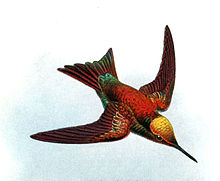Green-tailed emerald hummingbird
| Green-tailed emerald hummingbird | ||||||||||
|---|---|---|---|---|---|---|---|---|---|---|

Green-tailed Emerald Hummingbird ( Chlorostilbon alice ) |
||||||||||
| Systematics | ||||||||||
|
||||||||||
| Scientific name | ||||||||||
| Chlorostilbon alice | ||||||||||
| ( Bourcier & Mulsant , 1848) |
The green- tailed emerald hummingbird ( Chlorostilbon alice ) or Alice's hummingbird is a species of bird from the hummingbird family (Trochilidae). The species is endemic to Venezuela . The IUCN does not consider the population to be endangered ( Least Concern ), as it is listed there as a subspecies of the short-tailed emerald hummingbird ( Chlorostilbon poortmani alice ).
features
The green-tailed emerald hummingbird reaches a body length of about 7.2 cm, with the short beak 1.3 cm long. The head and neck of the male glitter gold-green. The back shimmers green with a copper-red tint. The underside is copper green, the short tail olive green and slightly forked. The three outer control spring pairs are very thin and spiky, the inner ones are significantly wider. The upper side of the female glitters green, has dark cheeks with a short white line behind the eyes. The underside is light gray. The dark green tail is short and has a dark subterminal band. The two outer pairs of control springs are streaked with large gray-white spots. The tail is even shorter in both sexes than in the short-tailed emerald hummingbird.
behavior
They are considered to be outspoken nectar thieves and poach in the territory of other birds such as z. B. that of the copper- rump amazilie ( Amazilia tobaci ( Gmelin, JF , 1788)) As a trapliner, they regularly fly in quick succession to very specific, scattered flowers with relatively little nectar yield and mostly the lower strata . These are often on the side of the road or in clearings. Most of the time they are on their own and rarely see trees in bloom.
Vocalizations
Their sounds sound like a thin, high and soft chatter, which they utter while searching for food.
distribution and habitat
They stay temporarily in the same area, although they move on seasonally. At relatively low altitudes, they move around dry and moderately moist forest edges, in gardens and cultivated landscapes with trees. In the higher altitudes, where they are less common, they can also be found on damp forest edges. They come to altitudes between 750 and 1800 meters at the northern end of the Andes of Trujillo and Lara , in the Sierra de San Luis in Falcón , in the mountains of Yaracuy , in the north of the Cordillera of Carabobo , in Aragua , in the Distrito Capital , in Miranda east to the Topo Golfo Triste , in Sucre without the Paria peninsula and in Monagas to Caripe .
Etymology and history of research

Jules Bourcier and Étienne Mulsant described the green-tailed emerald hummingbird under the name Trochilus Alice . They gave Caracas as the location . It was John Gould who introduced the new genus Chlorostilbon in 1853 . Only later was the green-tailed emerald hummingbird assigned to this genus. "Chlorostilbon" is made up of the Greek words "khlōros χλωρός " for "green" and "stilbōn στίλβων " for "shining". The Greeks gave Mercury the nickname Stilbōn, which is due to the verb "stilb" for "blink". To whom the specific epithet "alice" is dedicated is not apparent from the first description.
The species Panychlora micans described by Osbert Salvin in 1891 bears a certain resemblance to the green- tailed emerald hummingbird, but is now considered the noun dubium .
literature
- Steven Leon Hilty, John A. Gwynne, Guy Tudor : Birds of Venezuela . Princeton University Press, Princeton 2002, ISBN 0-691-09250-8 ( books.google.de ).
- James A. Jobling: Helm Dictionary of Scientific Bird Names . Christopher Helm, London 2010, ISBN 978-1-4081-2501-4 .
- Jules Bourcier, Étienne Mulsant: Description of the quelques nouvelles espèces d'oiseaux-mouches . In: Revue zoologique par la Société cuviérienne . 1848, p. 269-275 ( biodiversitylibrary.org ).
- John Gould: A monograph of the Trochilidæ, or family of humming-birds . tape 5 , delivery 5. Taylor and Francis, London 1853 ( biodiversitylibrary.org ).
- Frederick Herschel Waterhouse: The dates of publication of some of the zoological works of the late John Gould, FRS RH Porter, London 1885 ( biodiversitylibrary.org ).
- Osbert Salvin: Descriptions of new species of Upupæ and Trochili in the collection of the British Museum . In: The Annals and magazine of natural history; zoology, botany, and geology being a continuation of the Annals combined with Loudon and Charlesworth's Magazine of Natural History (= 6 ). tape 7 , 1891, p. 374-378 ( biodiversitylibrary.org ).
Web links
- Chlorostilbon poortmani inthe IUCN Red List of Threatened Species 2016.1. Listed by: BirdLife International, 2014. Retrieved August 28, 2016.
- BirdLife International: Species Factsheet - Green-tailed Emerald ( Chlorostilbon alice ) . Retrieved August 28, 2016.
- Videos, photos and sound recordings of Green-tailed Emerald (Chlorostilbon alice) in the Internet Bird Collection
- Green-tailed Emerald Hummingbird ( Chlorostilbon alice ) at Avibase; accessed on August 28, 2016.
- Chlorostilbon alice in the Integrated Taxonomic Information System (ITIS)
- xeno-canto: Sound recordings - Green-tailed Emerald ( Chlorostilbon alice )
- Green-tailed emerald hummingbird (Chlorostilbon alice) in the Encyclopedia of Life . Retrieved August 28, 2017.
Individual evidence
Remarks
- ↑ According to Frederick Herschel Waterhouse p. 47, Plate 355 appeared as part of Delivery 5 from 1853. Here Gould assigned the Chlorostilbon prasinus , a synonym for the blue-tailed emerald hummingbird ( Chlorostilbon mellisugus ( Linnaeus , 1758)) to the genus.
